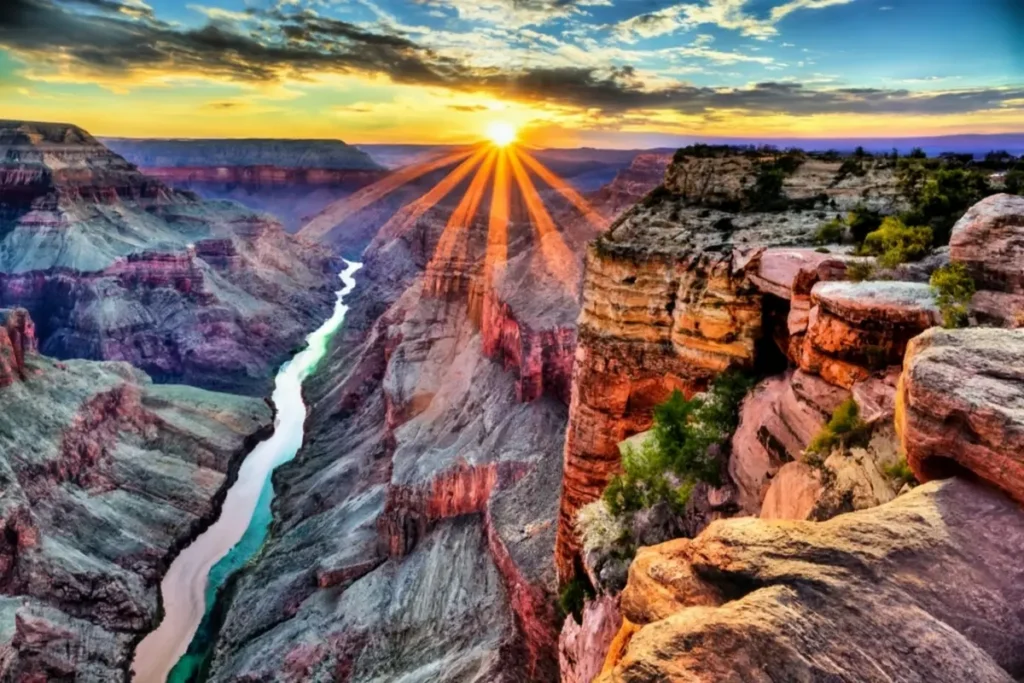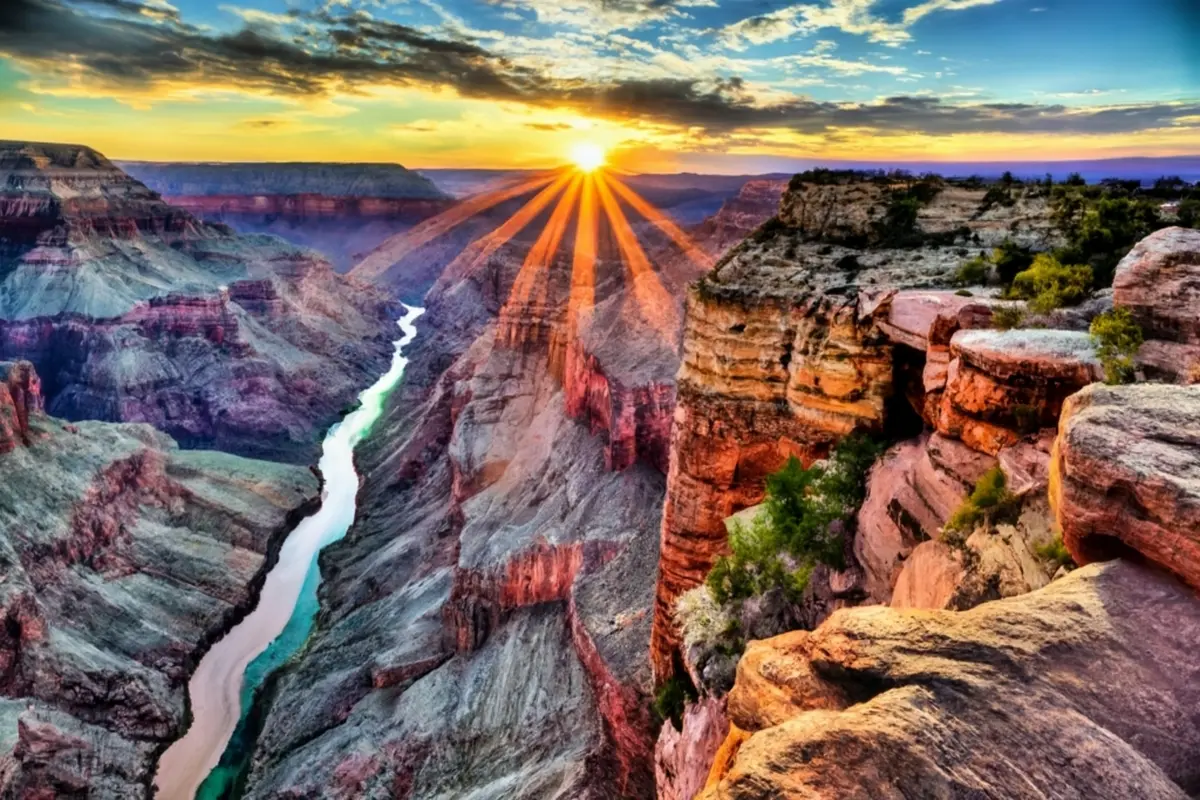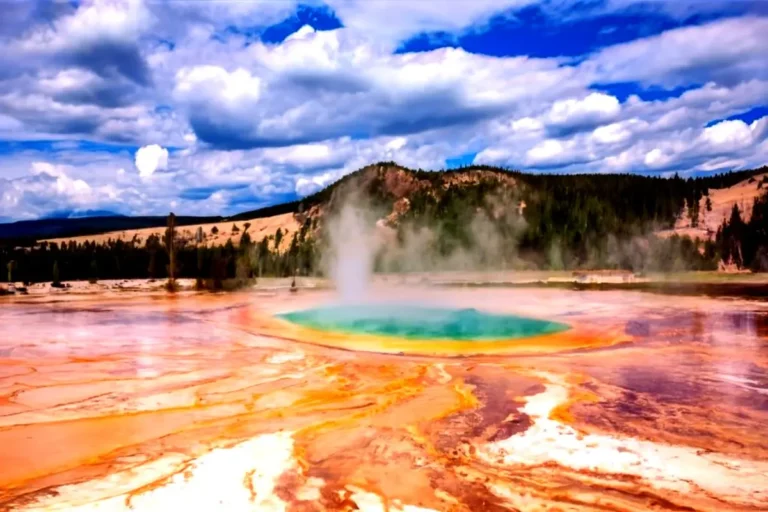Grand Canyon National Park:16 FAQ and Their Answers

Table of Contents
Your Instant Guide to Conquering the Grand Canyon’s Endless Adventures
The Grand Canyon is one of the most iconic natural wonders in the world.
Each year, over 5 million visitors flock to Grand Canyon National Park to marvel at its tremendous size, admire its layered geological revealing our planet’s history, and experience adventures ranging from scenic drives to whitewater rafting deep within the canyon walls.
With so many sights and activities spread across its vast 277-mile length, planning a successful trip to the Big Ditch can be daunting, especially for first-time visitors.
Below you’ll find answers to some of the most frequently asked questions about visiting the Grand Canyon.
You’ll learn about the best times to visit, how to choose between the North and South rims, why rafting through the canyon is so popular yet requires permits, and more insider tips to make the most of your Grand Canyon adventure.
With this advice straight from the park rangers and guides themselves, you’ll be equipped with the knowledge needed to properly prepare for an unforgettable journey to one of the Seven Natural Wonders of the World. So read on to start planning your own Grand Canyon escape today!
1. What is the history and formation of the Grand Canyon?

The Grand Canyon is one of the world’s greatest natural wonders and has a long and fascinating geological history going back billions of years. Though the precise timeline is debated by geologists, the accepted view is that the canyon began forming around 6 million years ago when the Colorado River first cut into the landscape.
However, the geological layers that make up the canyon walls and display its long history date back around 1.8 billion years.
The oldest rocks visible within the canyon are the schists and granite at the bottom which formed deep within the Earth’s crust.
Above this lies layer upon layer of different colored sedimentary rocks containing fossils, laid down over hundreds of millions of years when the region was submerged under ancient seas.
Some key events in the formation of the Grand Canyon are:
- 1.8 billion years ago: Oldest rocks formed deep underground
- 550 million years ago: Tapeats Sandstone deposited in an ancient ocean
- 375 million years ago: Limestones formed from coral reefs
- 300 million years ago: Kaibab Limestone from another shallow sea
- 70 million years ago: Uplift of the Colorado Plateau began
- 6 million years ago: The Colorado River cuts through the plateau carving the canyon
The river continues to widen and deepen the canyon today at an estimated rate of around 100-200 feet every 100 years. The depth of the Grand Canyon is now around 6000 feet from rim to river making it one of the deepest canyons in the world.
The Grand Canyon National Park was designated in 1919 to protect this incredible natural landscape. It receives around 6 million visitors a year who marvel at its sheer scale, beauty and exposed geology. For geologists, the canyon provides a unique visible record of the Earth’s long history.
2. What are the key geological features and layers visible in the Grand Canyon?

The Grand Canyon exposes an incredible sequence of colorful geological strata in its steep canyon walls that reveal the region’s natural history over a span of 1.8 billion years. The main rock layers visible are:
- Vishnu Schist and Zoroaster Granite: The dark blue-black schist and pinkish granite at the bottom of the canyon are the oldest rocks, formed 1.8 billion years ago deep inside the Earth’s crust.
- Tapeats Sandstone: This layer from 525 million years ago consists of sandstone in brown, purple, and red hues laid down in ancient seas.
- Bright Angel Shale: A 485 million year old greenish-gray mudstone containing many marine fossils.
- Muav Limestone: Gray, 375 million year old limestone also from an ancient shallow ocean environment.
- Redwall Limestone: Massive grey limestone with chert nodules, 340 million years old, named for its red color band.
- Supai Group: Red sandstones, siltstones and shale layers dating from 315 million years ago.
- Hermit Shale: Colorful slope forming shale and mudstone 270 million years old.
- Coconino Sandstone: Prominent white cliffs of cross-bedded sandstone from 275 million years ago.
- Toroweap and Kaibab Limestones: Gray cliffs forming the rim, 260 million years old from a shallow sea.
These layers tilt slightly due to uplift and erosion and their varying resistance to weathering forms the stair-stepped profile of the canyon walls. The sequence provides an invaluable record of regional geology across nearly two billion years of Earth history.
3. What are the different areas and viewpoints within the Grand Canyon National Park?

The Grand Canyon National Park covers a huge area of over 1,900 square miles along the course of the Colorado River.
Within the park, there are many famous scenic areas and viewpoints from the North Rim to the South Rim. Some of the major areas and viewpoints are:
- South Rim – The South Rim is the most accessible area with viewpoints like Mather Point, Yavapai Observation Station and Lipan Point offering panoramic canyon views.
- North Rim – The higher North Rim has its own scenic drive with viewpoints like Point Imperial and Cape Royal displaying the canyon’s full depth.
- Grand Canyon Village – The historic village on the South Rim has visitor services, museums, restaurants and lodges.
- Desert View – An area to the east of the village famous for the Desert View Watchtower offering views in both directions.
- Hermit’s Rest – Historic rest house at the western end of the South Rim after a scenic 7-mile drive.
- Bright Angel Trail – One of the most popular trails starting near the village and descending into the canyon.
- Indian Garden – A green oasis and popular halfway point along Bright Angel Trail.
- Phantom Ranch – Rustic lodge in the canyon bottom near the Colorado River that hikers can stay at.
- Havasupai Falls – Beautiful waterfalls visited via the Havasupai Reservation outside the park.
With so many iconic areas and overlooks, visitors are spoiled for choice when exploring the incredible landscapes of the canyon.
4. What sort of recreational options are available to visitors at the Grand Canyon?

The Grand Canyon offers endless opportunities for adventure and recreation. Popular activities include:
Hiking
- Hundreds of miles of maintained trails ranging from short easy-rim trails to multi-day treks into the inner canyon for experienced hikers. Famous trails include Bright Angel, South Kaibab and North Kaibab.
Backpacking
- Overnight backpack trips allow experience the canyon’s remoteness and camping at Phantom Ranch on the canyon floor. Wilderness permits are required.
Mule Rides
- Riding a mule along cliffside trails from the rim down to Phantom Ranch is a unique way to travel into the canyon without having to hike.
Rafting
- Rafting the Colorado River through the canyon is a multi-day wilderness trip offering stunning river-level views. Do-it-yourself or join guided tour groups. Permits required.
Cycling
- Biking along the rim trails of the South and North Rims is a scenic and leisurely way to explore the park. Rentals available.
Helicopter/Plane Tours
- Aerial tours offer a bird’s eye view of the canyon not visible from viewpoints on the rim. Landing tours to the canyon bottom also available.
Ranger Programs
- Join free guided ranger walks, talks, star parties and programs to learn more about the canyon’s geology, history, wildlife and more.
With endless sights and experiences, the Grand Canyon offers the adventure and trip of a lifetime no matter your ability or interest. Advance planning for permits, tours and lodging is essential for a smooth visit.
5. What are the different trails at the Grand Canyon and how difficult are they?

The Grand Canyon boasts over 800 miles of maintained trails that traverse its vast landscape both along the rim and far into its inner depths.
Some of the most famous and varied trails include:
- Bright Angel Trail – One of the most popular trails, starting on the South Rim near Grand Canyon Village and winding steeply down to the Colorado River. 14 miles roundtrip. Difficult.
- South Kaibab Trail – Gorgeous trail from the South Rim down to Skeleton Point and the river. Steep, exposed and unshaded. 7 miles roundtrip. Very Difficult.
- North Kaibab Trail – Descends from the North Rim all the way to the Colorado River crossing the Ribbon Falls. Difficult. 28 miles roundtrip.
- Hermit Trail – Historic trail on the South Rim travelling through multiple rock layers with canyon views. 10 miles roundtrip. Moderate to Difficult.
- Rim Trail – Easy paved trail along the South Rim from Hermits Rest to the village area offering stunning canyon vistas. 13 miles one-way. Easy.
- Widforss Trail – Loops through forested areas on the North Rim with views of five canyons. 10 miles roundtrip. Moderate.
- Havasupai Trail – Leads through Havasu Canyon with its stunning waterfalls and pools. Remote. 10 miles one-way to the falls. Difficult.
With trails ranging from wheelchair accessible rim walks to extreme multi-day treks, the Grand Canyon offers adventures for every ability and interest. Careful preparation and understanding trail difficulties is key for an enjoyable hike. Permits are required for overnight canyon trips.
6. What is the wildlife and vegetation that can be seen in the Grand Canyon area?

The Grand Canyon encompasses a variety of ecosystems that are home to an incredible diversity of hardy animals and plants.
Some wildlife visitors may glimpse include:
Mammals
- Mountain lion, bobcat, coyote, mule deer, desert bighorn sheep, ringtail, jackrabbit
Birds
- Condors, peregrine falcon, golden eagle, raven, turkey vulture, jay, canyon and rock wren
Reptiles
- Rattlesnake, gopher snake, collared lizard, desert tortoise, chuckwalla
Amphibians
- Red-spotted toad, canyon treefrog
Fish
- Rainbow trout, fathead minnow, speckled dace, humpback chub
Plants and Trees
- Pinyon pine, juniper, manzanita, agave, prickly pear cactus, cliff rose, rabbitbrush, cottonwood
The inner canyon holds desert habitat while the rim transitions through shrubland and pine forests. The canyon’s remote trails provide excellent wildlife viewing for those who venture into its depths. Bright Angel Creek attracts birds and mammals needing water. With over 1,700 plant species, the diversity of life in the canyon matches its landscape.
7. What are the best times and seasons to visit the Grand Canyon?

The Grand Canyon can be visited year-round but the best times are spring and fall when the weather is mildest.
Different seasons offer distinct advantages:
Spring (March to May)
- Warm weather is ideal for hiking into the canyon
- Wildflowers bloom on canyon walls
- Whitewater rafting water levels highest
- Crowds are smaller than summer months
Summer (June to August)
- South Rim open with warmer weather
- North Rim opens mid-May with cooler temperatures
- Summer thunderstorms possible
- High tourism season with bigger crowds
Fall (September to November)
- Pleasant weather and smaller crowds
- Fall colors in trees on canyon rims
- Cooler temps on the North Rim with possible snow
- Days shorter with earlier sunset times
Winter (December to February)
- South Rim is open year-round for amazing snowy vistas
- North Rim closes in mid-October due to snow
- Frigid inner canyon temperatures
- Freezing temperatures on the rim possible
- Lowest visitation of the year
Visiting during the shoulder seasons of spring and fall offers optimal weather conditions for most visitors. Checking ahead for North Rim seasonal closures and being prepared for variable weather any time of year is advised.
8. What places to stay are near Grand Canyon National Park?

The Grand Canyon offers a variety of lodging and camping facilities to accommodate the millions of annual visitors:
South Rim
- 6 lodges including El Tovar, and Bright Angel Lodge run by Xanterra Parks & Resorts
- Multiple campgrounds like Mather and Desert View
- Trailer Village for RVs
- Phantom Ranch lodging and camping on canyon floor for hikers
North Rim
- Historic Grand Canyon Lodge with cabins
- North Rim Campground near rim
- Closed mid-October through mid-May due to weather
Nearby Towns
- Hotels, motels, cabins and B&Bs in Tusayan, Williams, Flagstaff, Page
- Cafes and restaurants
- Gas stations and supply stores
Reservations Essential
- Book well in advance for rim lodges and Phantom Ranch
- Campsites can fill completely during summer
- Limit 14-day consecutive stay in campgrounds
With 5 million visitors annually, planning ahead for the limited lodging in the park is highly recommended. The gateway towns around the park offer abundant additional accommodation options a short drive from the canyon rims
9. What are the key tips for visiting and exploring the Grand Canyon National Park?

Visiting one of the Seven Natural Wonders of the World comes with some key tips to ensure you have the best Grand Canyon experience:
- Get permits for backcountry hiking, camping and canyon overnight stays well in advance. These are limited.
- Book hotels and lodges up to a year ahead for popular times. Phantom Ranch books out over 13 months in advance.
- Visit the East and West Rims for less crowded but still spectacular canyon viewpoints.
- Start early to beat crowds at popular South Rim viewpoints like Mather Point.
- Take the free shuttles to cut down on congested parking and rim driving.
- Layer clothing for variable and extreme temperatures on the rims and inner canyon.
- Carry plenty of water – at least a gallon per person for full-day hikes into the canyon.
- Know your limits when attempting challenging canyon trails. Do not hike to the Colorado River and back in one day.
- Visit North Rim in summer for cooler high-elevation temperatures. But services close mid-October to mid-May.
- Consider guided tours for informative ranger-led hikes or smooth rafting experiences.
Being prepared with permits, reservations and gear can ensure your Grand Canyon trip runs smoothly. But the key is taking time to marvel at one of the planet’s greatest natural wonders.
10. What makes the Grand Canyon one of the top natural wonders of the world?

The Grand Canyon is rightly considered one of the most spectacular natural marvels on the planet.
Some key reasons it is recognized as an international top natural wonder are:
- Immense scale – It spans 277 river miles in length, from 4 to 18 miles wide and over a mile deep. Few places showcase geology on such grand proportions.
- Awe-inspiring beauty – The interplay of rock layers, textures, colors and shadows creates incredible vistas and scenes that inspire wonder and photography.
- Geological significance – The exposed rocks showcase a beautiful visible record of over 2 billion years of North American geological history.
- Biodiversity – Despite harsh desert conditions, it sustains a remarkably wide variety of hardy wildlife and vegetative zones given varying elevations.
- Recreational diversity – Its immense wilderness offers endless adventures from challenging hikes to white water rafting to scenic flights suiting every ability.
- Accessibility – Its proximity to services and infrastructure allows millions easy access to appreciate the canyon’s grandeur each year.
- Cultural history – It has been home to native peoples for centuries and shaped the American West. Ancient artifacts and ruins trace human history.
- Global recognition – It is considered one of the Seven Natural Wonders of the World and one of the most photographed landscapes on Earth.
The Grand Canyon stuns by its sheer magnitude, intricate beauty, exposed geology, ecosystems and more. As a protected wonder experienced by millions, it promises to inspire and humble humanity for centuries to come.
11. Why is the Grand Canyon so popular?

The Grand Canyon is considered one of the top natural wonders of the world and receives over 5 million visitors per year, making it one of America’s most popular national parks. There are several key reasons the Grand Canyon captivates the imagination of so many each year:
First, its sheer immensity is awe-inspiring. The canyon spans 277 river miles in length and stretches from 4 to 18 miles wide from rim to rim. At its deepest point, the canyon plunges a full mile down to the Colorado River below. Few geological wonders can match the Grand Canyon’s monumental scale and massive depths that dramatically reveal the power of erosion over millions of years.
Second, the incredible geological showcase of the canyon’s stratified rock layers never ceases to amaze visitors. The vibrant bands of colored rock showcase over 2 billion years of North American history going back to some of the earliest landforms. This provides scientists an unparalleled record of our planet’s past unlike anywhere else in the world.
Third, the interplay of rock, color, shadow, and light creates stunning scenic vistas around nearly every turn. From popular overlooks to remote inner gorge viewpoints, photography enthusiasts can capture new breathtaking views unlike anywhere else on the planet. The canyon’s immense scale yet intricate details invite contemplation and wonder from all who gaze into its depths.
With so many incredible qualities, the Grand Canyon offers adventure, inspiration, discovery and humbling perspective all from one of Earth’s greatest natural canvasses. These factors combine to make it a life-long bucket list destination for travelers from around the world.
12. Why should I visit the North Rim instead of the South Rim?

The Grand Canyon National Park has two main rims, which offer very different experiences. Most visitors see the Grand Canyon from the more accessible South Rim, but visiting the North Rim provides some key advantages:
First, the North Rim is substantially less crowded than the popular South Rim. With only 10% of the park’s visitors, the viewpoints along the North Rim offer more isolation and quiet to appreciate the canyon sights.
Second, the views from the North Rim present the canyon in a different impressive perspective. From the higher elevation gazing south, the canyon appears wider, showcasing more of its intricate form and details.
Third, the North Rim’s higher elevation around 8,000 feet delivers cooler temperatures, which can provide welcome relief on hot summer days. The temperatures on the South Rim easily reach over 100 degrees Fahrenheit in summer.
However, the North Rim’s higher elevation comes with a shorter open season. The North Rim is only open from mid-May until mid-October due to hazardous snowy conditions the rest of the year. So travelers need to plan trips during this tighter window if they hope to visit the North Rim.
For travelers who don’t mind planning around the shorter season, a visit to the quieter and cooler North Rim offers a wholly different experience of one of America’s most iconic landscapes.
13. Why does the Grand Canyon have so many different rock layers?

The Grand Canyon provides one of the world’s most complete visible geologic columns, with over 40 major rock layers exposed in its steep cliffs. This is due to two key facts:
First, the regional geography has changed dramatically over the last 2 billion years from consisting of underground formations, to shallow ocean environments, to uplifted plateaus. This allowed for deposition of very different rock types under different conditions.
Second, the cutting action of the Colorado River has exposed and carved through over a billion years of these buried historical formations, bringing them to the surface in cross-section. Other forces like volcanism and erosion later added more layers on top.
The oldest rocks visible are the metamorphic schists and granite at the bottom which formed 1.8 billion years ago from heated and compressed underground strata. Marine deposits like the Tapeats Sandstone, Bright Angel Shale and Muav Limestone formed between 525 and 315 million years ago when the area was submerged.
More recent layers like the Coconino Sandstone and Kaibab Limestone formed as sand dunes and coral reefs when the area was a shallow sea. Uplift of the Colorado Plateau 70 million years ago initiated the carving of the canyon itself around 6 million years ago by the Colorado River.
This variety of environments, changing elevations, and ongoing erosion has given us the incredible geological layers seen today. Nowhere else on Earth displays such an expansive cross-section of the planet’s crust and history all at once.
14. Why is rafting the Colorado River through the canyon so popular?

Rafting the Colorado River through the entire 277 miles of the Grand Canyon is an iconic adventure that allows experiencing this natural wonder in the most immersive way possible. Several factors make rafting the canyon stretch of the river so popular:
First, a multi-day rafting trip allows access to the remote inner canyon not visible at all from the rim viewpoints. Camping right at the river level provides an up-close perspective of the canyon’s towering rock walls, bends and side canyons.
Second, the river provides a cool respite from the desert heat while slowly floating through the changing canyon scenery for days. Without having to exert effort hiking, rafters can relax and absorb the sights at a calm pace.
Third, the smooth sections of the river allow appreciation of the tranquility, geology and wilderness unique to the canyon. While some rapids add excitement, the overall pace fosters reflection.
Fourth, guides provide fascinating facts about the canyon’s natural and cultural history to enrich the experience. Expert navigators ensure guests’ safety through the biggest rapids.
Finally, the logistical challenges of organizing a multi-day canyon rafting trip means most people will only get to do it once in their lifetime. This “bucket-list factor” adds to the trip’s allure and memorability.
For these reasons, rafting the length of the Grand Canyon provides adventure seekers with an epic journey and memory sure to last a lifetime.
15. Why are permits required for many Grand Canyon activities?

The National Park Service requires permits for backcountry camping, extended overnight hiking, and river rafting within the Grand Canyon in order to balance preservation and recreation in the park. The main reasons are:
First, permits limit human impacts within the park. With over 5 million annual visitors, uncontrolled access could lead to pollution, overcrowding, damage and wildlife disruption. Permits manage popular areas to sustainable levels.
Second, the permits help ensure user safety in extremely remote areas far from help. Hikers must prove adequate preparation and self-reliance for extended stays deep within the canyon, sometimes weeks from the nearest road.
Third, the fee revenue generated from permits helps fund park maintenance and operations to maintain trails, facilities, signs, etc. This ensures the infrastructure supports responsible recreation.
Fourth, the permit process allows education on low-impact practices like waste removal, trail etiquette, sanitation, fire bans and avoiding cryptobiotic soil crusts. This protects park resources for future generations.
Finally, the limited number per day or season makes acquiring a permit special. Lotteries give everyone a fair chance. This leads to greater visitor satisfaction.
While permits may limit spontaneity, they are critical to the Grand Canyon. As more people seek remote adventures within the park, permits become more vital for stewardship and preservation for the years ahead.
16. Why should I leave my itinerary flexible when visiting the canyon?

With unpredictable weather and immense scale, the Grand Canyon requires flexible itineraries to allow adjusting for conditions.
A few factors make flexibility wise:
First, the canyon has highly variable microclimates. A pleasant 70 degrees F at the rim can be 110 degrees F at the bottom with intense sun exposure. Thunderstorms can form suddenly impacting trails and viewpoints.
Second, some areas like the North Rim have seasonal closures from October through May due to snow, requiring alternates if visiting then.
Third, trails may close due to rockslides, floods or other safety hazards. Having backup choices for activities allows adjusting.
Fourth, access between some areas like the North and South Rim requires long driving distances. Building buffer days prevents rushed itineraries.
Finally, time expectations at viewpoints or on hikes may exceed reality once encountered, especially with crowds. Extra time prevents exhaustion or disappointment.
While advance reservations for lodging, tours and permits are still a must, leaving flexibility around activities, routes and dates can prevent Grand Canyon visits from becoming stressful or dangerous. Embracing spontaneity lets you seize opportunities when amazing sights appear.
Key Takeaways
Key Takeaways on the Grand Canyon National Park
- The Grand Canyon began forming around 6 million years ago but its rock layers showcase over 2 billion years of geological history.
- The Colorado River carved through layers of rock creating immense cliffs, ledges and depths up to 1 mile deep.
- Layers of colorful sedimentary rocks like sandstones and limestones create its banded landscape.
- Viewpoints along the South and North Rim like Mather Point offer breathtaking canyon vistas.
- Popular activities include day hikes, backpacking, mule rides, rafting and scenic flights.
- Facilities like lodges and campgrounds book up far in advance due to high demand.
- Permits are required for overnight canyon trips and backcountry camping.
- Spring and fall are the best times to visit when temperatures are milder.
- It is considered one of the top natural wonders in the world for its beauty, geology and wilderness adventures.
Conclusion

The Grand Canyon is a top global destination that draws visitors from around the world for good reason – its immense size, intricate beauty, and wealth of adventures appeal to all sorts of travelers.
This natural wonder reveals unique perspectives from both the popular South Rim and the quieter North Rim. Its exposed rock layers illustrate a geological story over 2 billion years in the making.
Rafting the Colorado River provides a bucket list adventure through the canyon’s remote depths. Permits carefully regulate access to balance enjoyment and preservation.
With climate extremes and unpredictable conditions, flexibility is key when planning a Grand Canyon visit. Yet with careful preparation and research, you’re sure to have an unforgettable experience at one of the most impressive natural landscapes on Earth.
Whether you seek breathtaking views from scenic overlooks or prefer daring hikes deep into the canyon, the Grand Canyon offers sights and activities to satisfy any interest. So start planning your own National Park Service-approved adventures today to see this natural wonder for yourself.
- The Grand Canyon National Park is a bucket list destination renowned for its immense scale, intricate rock layers, incredible hiking, and stunning scenic vistas.
- Millions visit each year to marvel at its awe-inspiring natural beauty and glimpse into geological history.
- Advanced planning for activities, lodging, and permits can ensure an enjoyable visit to this natural wonder.






